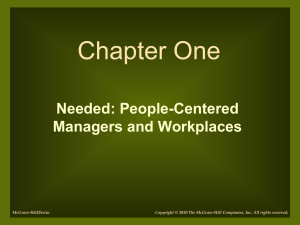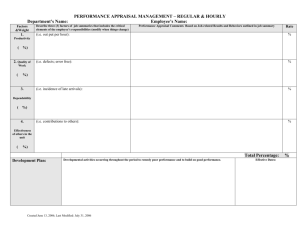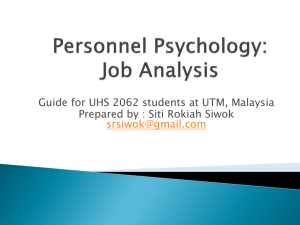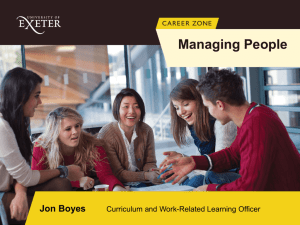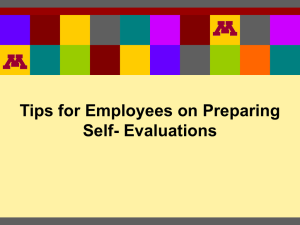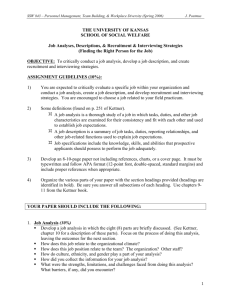Human Resource Management
advertisement
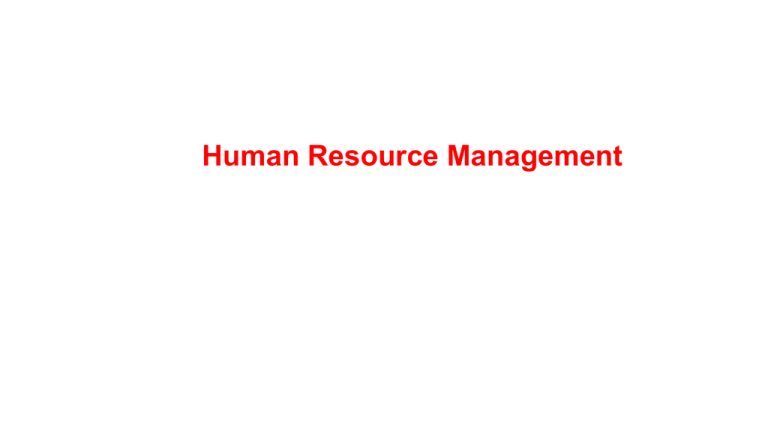
Lecture# 11 (Lecture Outline and Line Art Presentation) Human Resource Management Lecture Objectives 1. Explain what human resource management involves. 2. Define the term human capital and identify at least four of Pfeffer’s peoplecentered practices. 3. Identify and briefly explain the seven steps in the PROCEED model of employee selection. 4. Distinguish among equal employment opportunity, affirmative action, and managing diversity. 5. Explain how managers can be more effective interviewers. 6. Discuss how performance appraisals can be made legally defensible. Lecture Outline and Line Art Presentation, 11–2 Human Resource Strategy: A People-Centered Approach • Human Resource Management (HRM) • The proactive acquisition, retention, and development of human resources necessary for organizational success. • HRM has moved from a support staff function (personnel) to a more strategic role in organizations. • Human Capital - All present and future workforce participants who need to develop to their full potential as valuable assets to organizations. Lecture Outline and Line Art Presentation, 11–3 Figure 11.1 A General Model for Human Resource Management Human Resource Strategy: A People-Centered Approach (cont’d) • People-Centered Organizations Enjoy a Competitive Advantage • People-centered practices • Protection of job security. • Rigorous hiring process. • Employee empowerment. • Compensation linked to performance. • Comprehensive training. • Reduction of status differences. • Sharing of key information. Lecture Outline and Line Art Presentation, 11–5 Human Resource Strategy: A People-Centered Approach (cont’d) • Recruitment and Selection • “Getting the right people on the bus.” • Recruiting for diversity • Goal is to generate a pool of qualified applicants through many different sources that are demographically representative of the population at large. • Networking appears to be the most successful job-hunting method. Lecture Outline and Line Art Presentation, 11–6 Human Resource Strategy: A People-Centered Approach (cont’d) • The Selection Process: An Overview • Steps in the PROCEED model (Still’s model) • Prepare • Review • Organize • Conduct • Evaluate • Exchange • Decide Lecture Outline and Line Art Presentation, 11–8 Human Resource Strategy: A People-Centered Approach (cont’d) • Job analysis • The process of identifying basic task and skill requirements for a specific job by studying superior performers. • Job description • A concise document that outlines the role expectations and skill requirements for a specific job. Lecture Outline and Line Art Presentation, 11–11 Human Resource Strategy: A People-Centered Approach (cont’d) • Equal Employment Opportunity (EEO) • EEO and Title VII of the Civil Rights Act of 1964 • In virtually all aspects of employment, it is unlawful to discriminate on the basis of race, color, sex, religion, age, national origin, disability, or veteran status. • Affirmative Action • A plan for actively seeking out, employing, and developing the talents of those groups traditionally discriminated against in employment. Lecture Outline and Line Art Presentation, 11–12 Recruitment and Selection • Employment Selection Tests • Any procedures used in the employment decision process such as • • • • • Pencil-and-paper tests Unscored application forms Informal and formal interviews Performance tests Physical, education, or experience requirements • Tests must be unbiased, statistically valid, and reliable predictors of job success. Lecture Outline and Line Art Presentation, 11–13 Recruitment and Selection (cont’d) • Effective Interviewing • Interviews are the most common selection tool. • Shortcomings of unstructured interviews • • • • • • • • Highly susceptible to distortion and bias. Highly susceptible to legal attack. Legally indefensible if contested. Apparent but no real validity. Not totally job-related and possibly invasive of privacy. Highly inconsistent in application as selection tool. Subject to interviewer bias (e.g., cultural bias). No feedback about selection errors. Lecture Outline and Line Art Presentation, 11–16 Recruitment and Selection (cont’d) • Effective Interviewing (cont’d) • Structured interviews: a set of job-related questions with standardized answers. • Question types used in structured Interviews • • • • Situational Job knowledge Job sample simulation Worker requirements • Behavioral Interviewing • Asking detailed questions about specific behavior in past job-related situations. Lecture Outline and Line Art Presentation, 11–17 Performance Appraisal • Performance Appraisal • Evaluating individual job performance as basis for making objective personnel decisions. • Making Performance Appraisals Legally Defensible • Use job analysis to develop the appraisal system. • Check that the appraisal system is behavior-oriented, not trait-oriented. • Have evaluators follow specific written instructions when conducting appraisals. • Have evaluators review results with the rates. Lecture Outline and Line Art Presentation, 11–18 Figure 11.2 A Sample Behaviorally Anchored Rating Scale for a College Professor Source: From PERFORMANCE APPRAISAL: ASSESSING HUMAN BEHAVIOR AT WORK, 1st edition, by Bernardin, Beatty. Copyright © l984. Reprinted with permission of South-Western College Publishing, a division of Thomson Learning. Fax 800-730-2215. Training • Training Facts • 56.8 billion dollars were spent on employee training in 2001, although most of it was spent on well-educated managers and professionals. • Remedial education and basic skills training for nonmanagement personnel is both a business necessity and a good investment for employers. • The bulk of training is low-tech, not computer-based and e-learning over the Internet. Lecture Outline and Line Art Presentation, 11–21 Figure 11.3 The Content and Delivery of Today’s Training Source: Republished with permission of TRAINING from Tammy Galvin, "2001 Industry Report," TRAINING, 38 (October 2001): 54, 66; permission conveyed through Copyright Clearance Center, Inc. Training (cont’d) • The Ingredients of a Good Training Program • • • • • • • • Maximize similarity between the training and the job. Provide as much experience as possible. Provide a variety of examples. Label or identify important task features. Make sure general principles are understood. Reward trained behaviors and ideas. Design training content for obvious applicability. Use questions to guide trainee’s attention. Lecture Outline and Line Art Presentation, 11–23 Training (cont’d) • Skill Versus Factual Learning • Effective skill learning ingredients 1. Goal setting 2. Modeling 3. Practice 4. Feedback • Effective factual learning sequence 1. Goal setting 2. Meaningful presentation of materials 3. Practice 4. Feedback Lecture Outline and Line Art Presentation, 11–24 Contemporary Human Resource Challenges and Problems • Discouraging Sexual Harassment • Sexual harassment: unwanted attention that creates an offensive or intimidating work environment. • Unwanted physical contact • Gestures, displays, joking, and language • It is the manager’s job to be aware of and to correct cases of harassment. Ignorance of such activity is not a valid legal defense. Lecture Outline and Line Art Presentation, 11–25 Contemporary Human Resource Challenges and Problems (cont’d) • Controlling Drug and Alcohol Abuse • Alcoholism: a disease in which alcohol disrupts one’s normal life. • Drug abuse costs employers $100 billion each year. • The Legal Side of Workplace Substance Abuse • Drug addicts and alcoholics are covered by Vocational Rehabilitation Act of 1973. • Employers with federal contracts exceeding $25,000 must comply with the Federal Drug-Free Workplace Act of 1988. Lecture Outline and Line Art Presentation, 11–27 Contemporary Human Resource Challenges and Problems (cont’d) • Referral and Rehabilitation • How to assist an abusing employee • Don’t accuse the employee; offer help after the employee self-admits the problem. • Don’t “play doctor.” • Refer the employee to an employee assistance program (EAP) or community resources for rehabilitation. Lecture Outline and Line Art Presentation, 11–28
